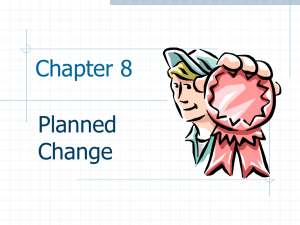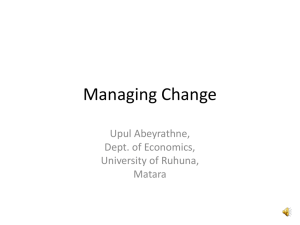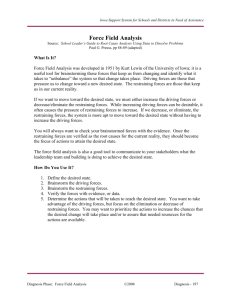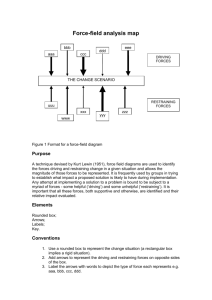Force Field Analysis
advertisement
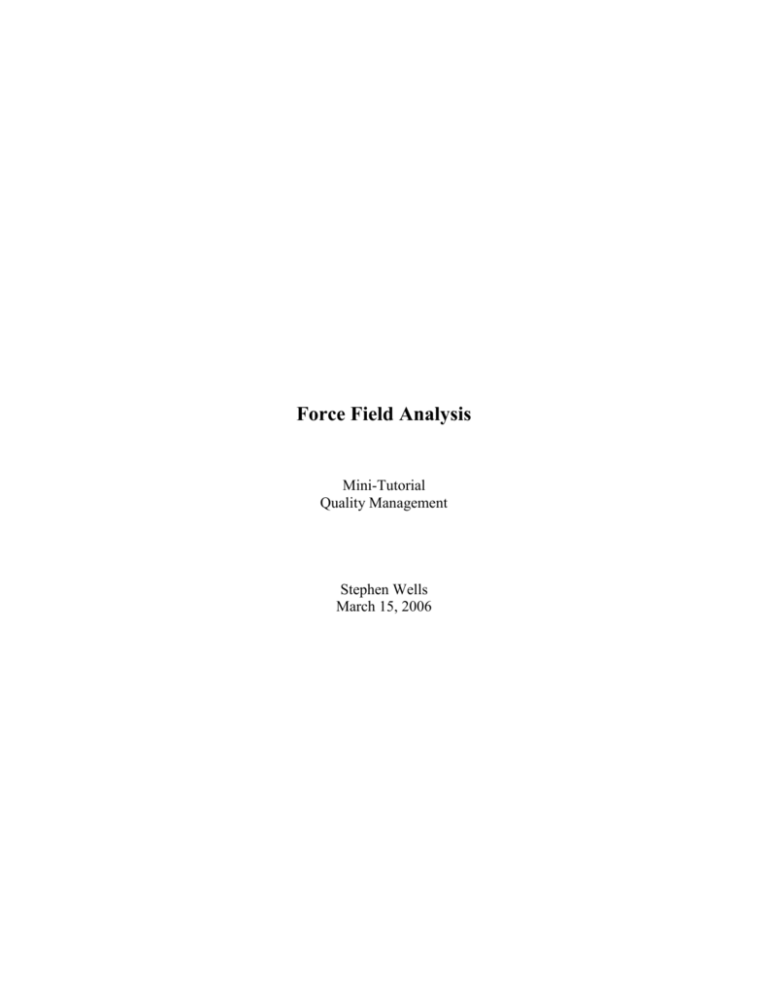
Force Field Analysis Mini-Tutorial Quality Management Stephen Wells March 15, 2006 Introduction Force field analysis is a valuable change-management tool. This management technique was developed by Kurt Lewin, an expert in experiential learning, group dynamics and action research. Although Kurt Lewin contributed greatly to the field of social science, he is bestknown for his development of the Force field analysis model in 1947. Lewin’s force field analysis is evaluates the net impact of all forces that influence change. These forces can be divided into two groups: driving forces and restraining forces. Driving forces are all forces that push for and promote change. These change drivers promote and encourage the change process. Some examples of driving forces are executive mandate, customer demands, and increased efficiency. Restraining forces are forces that make change more difficult. These forces counteract driving forces and lead to the avoidance or resistance of change. Some examples of restraining forces are fear, lack of training, and the lack of incentives. When these two sets of forces are equal change is in a static state of equilibrium meaning that no movement towards or away from change is happening. To better understand the connection between driving and restraining forces and how they impact change; a simple metaphor is of use (see illustration below). Suppose a group of helium-filled balloons are attached to a set of weights. The helium in the balloons creates an upward lift of five pounds. The weight of the attached weights is also five pounds. Because both the driving forces (balloons) and the restraining forces (weights) are equal, the balloons are unable to lift off the ground towards change. However, the addition of a single balloon or the removal of a single once of weight would change the balance and would start the system rising towards the envisioned change. Figure 1.1 Change 1 Implementation This section discusses how to implement the force field analysis into a business setting. Although there are several different methods and variations for conducting force field analysis, there are commonalities among all of them. The steps outlined below capture many of these commonalities and represent the process needed for successful implementation of a typical force field analysis. 1. Identify and understand the current state 2. Identify and understand the desired goal state relative to the proposed change. 3. Identify and list driving forces acting to support the change. It is important to list all forces regardless of their seemingly small influence. Driving forces are forces acting to move the current state towards the goal state. 4. Identify and list restraining forces acting to hinder the change. Remember restraining forces are forces holding the current state back from the goal state. 5. For each force, designate the level of influence using a numerical scale e.g. 1=extremely weak and 7=extremely strong. 6. Chart the forces by listing the driving forces on the left and restraining forces on the right. Also chart the numbers allocated in step 5 next to their related force. 7. Evaluate the chart and determine whether change is viable. 8. Discuss how the change can be affected by decreasing the strength of the restraining forces or by increasing the strength of driving forces. 9. Discuss action strategies to eliminate the restraining forces and to capitalize on the driving forces. Through conducting this process, a force field diagram like the one shown in figure 1.2 should be created. Figure 1.2 Strength Strength Driving forces Restraining forces 4 Increased efficiency Capital investment 3 3 Customer demands Fear 7 5 Executive mandate Lack of incentives 4 4 Trust in unit leader Lack of training 3 17 No Change Equilibrium 16 2 Change As shown in the above force field diagram, the total point value for restraining forces exceeds the total value of the driving forces. This means that the proposed change would likely fail if nothing is done to change the balance. To increase the likelihood of success, management can attempt to reduce restraining forces, increase driving forces, or some combination of the two. In changing the impact of one force, the impacts of other forces often change as well. One example of this interdependency would occur if management decides to reduce the level of employee fear be providing extra training and resources. The impact of fear as a restraining force may drop from a 7 to a 4, but the capital investment restraining force may increase from a 3 to a 7 resulting in a higher restraining force than before the change. The relationships among the many forces must be understood and evaluated before strategies to eliminate the restraining forces and to capitalize on the driving forces are implemented. Applications Force field analysis is being used for many different applications in a wide variety of industries. There are three main applications of the force field analysis tool: 1. Change management (which has been the focus of this article) 2. productivity improvement 3. decision making Change management is the primary application for force field analysis. One industry that has embraced the usefulness of this tool is the health care industry. Change is a regular occurrence in the healthcare environment. One area of change in which the health care industry has used force field analysis is in the computerization of nursing systems. Nurses have widely varying attitudes toward computers and change in the workplace. To help in the transition, managers are evaluating the forces that encourage and the forces that impede the change. Based on the force field analysis, strategies must be developed to assist nurses in moving forward with the transition. Productivity improvement is the second main application of force field analysis. This universal application of how to increase employee productivity demonstrates a powerful need for the force field analysis tool. Instead of looking at factors promoting and inhibiting change, managers can look at forces promoting and inhibiting productivity. This analysis can shed light on methods, strategies, and systems that can promote long-term improvements in employee productivity. Force field analysis is also a powerful decision-making tool. By evaluating the forces supporting and opposing a specific decision, managers can know the likelihood of acceptance and can also manage the influencing forces to maximize the potential for acceptance and success. The force field model is a valuable tool for use in these three applications; however, it is not limited to these forms of application. By understanding the principles of force field analysis, managers can customize the technique for use in a large variety of situations. By recognizing that every decision and every change has forces that promote the change and forces that impede the change, managers can make smarter decisions and can use force field analysis to effectively manage change in their organizations. 3 Sources for more Information Although there are no books dedicated to force field analysis, there are many sources available to further learn about methods and applications of this diverse and effective tool. Here are a few that I have used in my research of force field analysis. Force Field Analysis: A New Way to Evaluate Your Strategy Thomas, Joe. Long Range Planning. London: Dec 1985.Vol.18, Iss. 6; pg. 54, 6 pgs Implementing great new ideas through the use of force-field analysis (Part three of a series) Floyd Hurt. Direct Marketing. Garden City: May 1998.Vol.61, Iss. 1; pg. 54, 3 pgs Force Field Analysis: New Tool for Problem Solving Tucker, Kerry. The Public Relations Journal. New York: July 1979.Vol.35, Iss. 7; pg. 23 Using Lewin's Force Field Analysis in Implementing a Nursing Information System.Authors:MARILYNN G. BOZAKSource:CIN: Computers, Informatics, Nursing; Mar/Apr2003, Vol. 21 Issue 2, p80-85, 6p Management of change through force field analysis.Authors:Baulcomb, Jean Sandra1Source:Journal of Nursing Management; Jul2003, Vol. 11 Issue 4, p275-280, 6p *Focusing leadership through force field analysis: new variations on a venerable planning tool Randolph E Schwering. Leadership & Organization Development Journal. Bradford: 2003.Vol.24, Iss. 7/8; pg. 361, 10 pgs *Assessing prospects for organizational change: The uses of force field analysis Brager, George, Holloway, Stephen. Administration in Social Work. New York: 1992.Vol.16, Iss. 3,4; pg. 15, 14 pgs http://www.valuebasedmanagement.net/methods_lewin_force_field_analysis.html http://www.accel-team.com/techniques/force_field_analysis.html http://www.mindtools.com/forcefld.html http://www.wiley.co.uk/innovate/website/pages/atoz/ffa.htm http://www.brainstorming.org/book/c5.shtml http://web.mit.edu/hr/oed/learn/change/tool_forcefield.html 4
